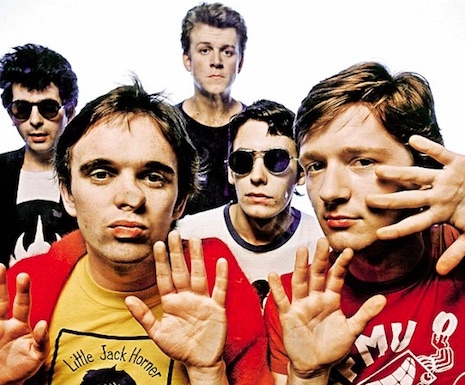
Squeeze: The classic line-up.
Like everyone else, I’m a sucker for a song that marries a well-crafted lyric to an unforgettable tune. That for me is what makes classic popular music. It can be Chuck Berry with “No Particular Place To Go,” or Sparks with “Something for the Girl with Everything,” Lou Reed’s “Walk on the Wild Side,” or even a music hall number like “My Old Man (Said Follow the Van),” or George Formby’s “When I’m Cleaning Windows.” Each of these songs has a clever lyric that tells a little story matched by compelling music that carries us along to a little nirvana of pure pop joy.
Chris Difford and Glenn Tilbrook write these kinds of perfect songs. Songs like “Up the Junction,” “Tempted,” “Labelled with Love,” “Another Nail in My Heart,” “Cool for Cats,” “Black Coffee in Bed,” and “Pulling Mussels (from the Shell).” Beautiful works of art that touch both heart and mind.
Together Difford and Tilbrook are the core of Squeeze—the band they formed sometime in late 1973 or early 1974. It all started after Difford put an advert in a newsagent’s window for a musician to gig and record with, who liked the Small Faces, Hendrix and Glenn Miller. Difford had been writing poetry for years but had a desire to write and perform songs. Tilbrook had been playing guitar and writing songs since around the age of eleven. He was the only musician who replied to Difford’s ad. It was one of those marvelous quirks of fate that brought together the two young men who would one day be hailed as the “new Lennon and McCartney.”
Difford and Tilbrook were joined by boogie-woogie pianist Jools Holland on keys, Gilson Lavis on drums and eventually John Bentley who replaced Harry Kakoulli on bass. This became the classic Squeeze line-up. Through their manager Miles Copeland III (who also managed the Police, and later released albums by R.E.M., the Cramps and the Bangles), the band had their first EP A Packet of Three and their first album produced by John Cale.

Squeeze: The eighties line-up.
Difford and Tilbrook had taken the name Squeeze from the Velvet Underground’s (worst) album Squeeze, so there was some synchronicity that Cale produced Squeeze’s earliest output. But Cale wanted sex and imagined passions rather than the world of personal experience and kitchen-sink drama from which Difford pulled his cache of working class poetry. Whereas the first album and single (“Take Me I’m Yours”) put the band on the map and led to their three-month tour of America, it was the second Cool for Cats that showcased Difford and Tillbrook’s genius for songwriting, which was followed by the classic albums Argybargy and East Side Story, right up through to the band’s fourteenth studio album Cradle to the Grave in 2015.
Squeeze arrived at a time of a great and rich musical diversity. When there were various genres like punk and ska, new wave and rap, disco and synthpop, and so on. It was also a time when pop music no longer had that shiny exciting novelty it once had in the fifties and sixties, which meant that sometimes the praise and respect Difford and Tilbrook richly deserved was occasionally diminished or overlooked by rock critics searching for the next Sex Pistols or Paul Weller. Not that Squeeze weren’t popular or greatly loved, far from it, but that there was an equally talented (and often times not as talented) number of other bands also demanding attention who were simply less conventional.
Watch Squeeze in concert from 1982, after the jump…





